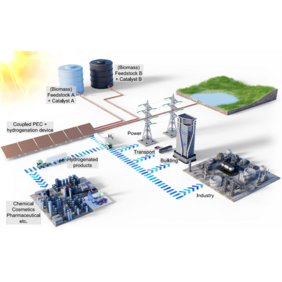Solar water splitting through photoelectrochemical (PEC) approaches is an elegant way to produce green hydrogen, but for low-value products like hydrogen, PEC production pathways make it difficult to achieve economic competitiveness. A possible solution is to co-produce value-added chemicals. In their publication, the UniSysCat teams of Roel van de Krol and Reinhard Schomäcker demonstrate the in situ use of (photo)-electrochemically generated H2 for the homogeneous hydrogenation of itaconic acid—a biomass-derived feedstock—to methyl succinic acid. Coupling these two processes offers major advantages in terms of stability and reaction flexibility compared to direct electrochemical hydrogenation. The direct utilization of a part of the hydrogen for generating a value-added chemical greatly improves the economic viability of the process.
Keisuke Obata, Michael Schwarze, Tabea A. Thiel, Xinyi Zhang, Babu Radhakrishnan, Ibbi Y. Ahmet, Roel van de Krol, Reinhard Schomäcker & Fatwa F. Abdi, Solar-driven upgrading of biomass by coupled hydrogenation using in situ (photo)electrochemically generated H2, Nature Communications | (2023) 14:6017, https://doi.org/10.1038/s41467-023-41742-4



